CreativiTree Generating cool trees in Minecraft!
Final Report
Video
Project Summary
We want to build computer generated trees in Minecraft. This would be a trivial problem if we simply wanted to convert images into object in Minecraft. However, we want to generate trees that have never been seen before – unique and new trees. Thus, we need AI/ML algorithms to solve it.
Our main goal for our project is to generate the best images of trees to build in Minecraft. However, this goal is very difficult to achieve, because it adds more complexity, which we did not want to take on at this time. This complexity involves finding which images look the best in Minecraft. This is a difficult task because the images that do not look like trees may look more like trees in Minecraft than realistic tree images. Thus, our new goal is to generate trees, which look the most like trees, then convert the best into Minecraft.
Our project, CreativiTree, is a deep learning tool that “hallucinates” new images of Trees and generates them for the player in-game. CreativiTree is fed thousands of images of trees using generative adversarial networks in order to “hallucinate” new images of trees and then turning them into minecraft objects using malmo.
Approaches
Our project is using a DCGAN, which is a Deep Convolutional Generative Adversarial Neural Network. It consists of two separate neural networks who ‘compete’ against each other to generate and discriminate images.
What is a GAN, DCGAN, and “hallucinating” images?
Our project involves “hallucinating” images–what do we mean by this? Well, if we were to analogize this to human hallucination, we would say that “hallucinating” is seeing something that isn’t there. There may be the real, physical object that may influence or inspire the inspiration, but the hallucination itself does not represent reality.
So, when we say that CreativiTree “hallucinates” trees, we are saying that it generates images of trees that it thinks actually exists, but does not actually exist. It does not just remember or learn what trees look like from images of trees, which is a technique that’s closer to variational autoencoders (VAE). Our AI instead thinks of random noise at first, and is taught to think of trees until it does a good job of thinking of trees–or “hallucinating” them. The results are quite interesting, as it ends up hallucinating trees that can often look quite different than realistic trees.
In order for CreativiTree to “learn” about trees, we used a TensorFlow implementation of DCGAN that we found on github. This, along with thousands of 32x32 color tree images from the CIFAR-100 dataset.
A quick overview of neural networks:
- A neural network is a web of “neurons” that are interconnected with each other, structured in a way that may include multiple layers of these neurons.
- These neurons are functions that take in a matrix of numbers, computes the matrix through some sort of activation function, and then outputs a matrix of changes that are to be applied elementwise for the next neuron in their activation function.
A GAN is a generative adversarial neural network. In our case, the “generative” aspect is generating images that resemble real photographs of trees. The “adversarial” aspect is due to how the GAN is structured.
- A GAN has two neural networks competing against each other in a zero-sum game.
- One of the neural networks is called a generator. Its job is to generate images as close to the “real” images as possible.
- One of the neural networks is called a discriminator. Its job is mainly to tell the generated images from the real images. Its output is whether the image is real or generated (“fake”), and the generator adjusts its learning according to the discriminator’s output.
A DCGAN is a GAN that uses deep convolutional layers as part of its architecture. You can think of it as a convolutional neural network (CNN) and a GAN combined.

- The discriminator is a convolutional neural net, with four convolutional layers.
- The generator is a deconvolutional neural net, with four deconvolutional layers. You may notice that the generator is essentially the discriminator, but flipped.

The way a DCGAN works is that we first set up the discriminator and the generator up, randomizing the weights and biases of the neurons with a Gaussian distribution. Then, we have something for the generator to “generate” on: a z vector of random numbers drawn from, again, a Gaussian distribution. This z vector can be thought of as a “seed” matrix.
We then train the discriminator first:
_, summary_str = self.sess.run([d_optim, self.d_sum],
feed_dict={ self.inputs: batch_images, self.z: batch_z })
self.writer.add_summary(summary_str, counter)
Here, you can see that we feed the discriminator both the real images (“batch_images”) and the generated images (“batch_z”).
We then train the generator based on the feedback (“batch_labels”) given by the discriminator:
_, summary_str = self.sess.run([g_optim, self.g_sum],
feed_dict={
self.z: batch_z,
self.y:batch_labels,
})
self.writer.add_summary(summary_str, counter)
The Learning & Training
We trained the DCGAN and found the higher number of epochs the better in general. The generated trees started looking better and better, but towards the end, the trees started looking strange. We think this is because the DCGAN is learning the background of the images, instead of the tree itself.
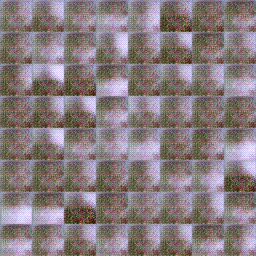
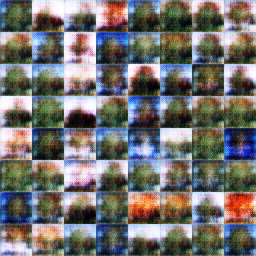
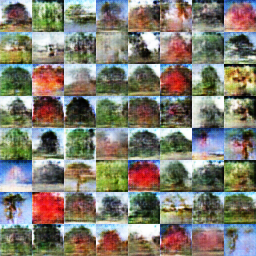
Data Distortion We added extra data by distorted our original dataset slightly. We were able to go from 2500 datapoints to 5500 datapoints. We were hoping that with the new increased dataset size, we could generate better trees. Here are some of the new epochs generated:
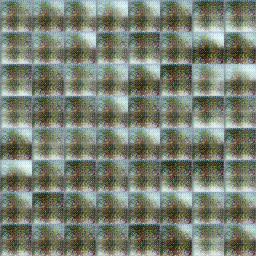
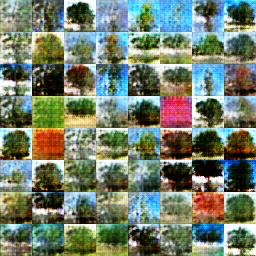
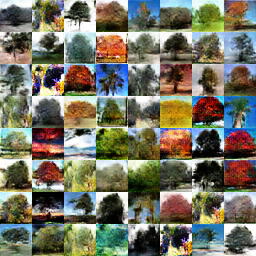
Learning rate In addition to the new dataset, we also changed the learning rate to see if that affected the tre generation. Is it standard to use a low learning rate for neural networks, so we tried lowering the learning rate to see if it could generate better trees.

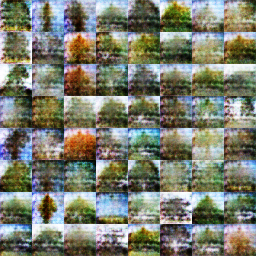
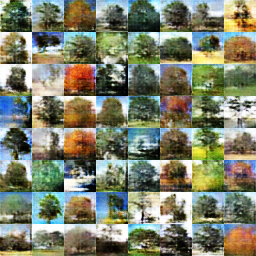
Malmo We used the Python Imaging Library to convert each image to RGB representations in Python. We then used the webcolors API, to convert each pixel to a color that can be rendered in Minecraft. At first, we needed to tweak the colors so that it would accurately convert to the correct colors, and the resulting (unscaled) images are as follows:
Next, we scaled the representations into 10x10 models, which looked kind of strange, but they were player size. Something we could improve on is scaling the images to look more like the unscaled versions.
The results of our prototype:
Unscaled 32x32 tree images converted into Minecraft:
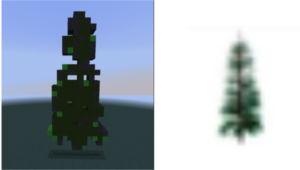
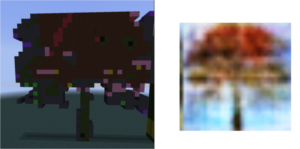
Final product


Evaluation
We broke down our evaluation into three parts:
1. Did our project generate tree images that actually look like trees?
For the first evaluation, we analyzed the results of generator given different epochs. At first we trained the DCGAN using 35 epochs, which gave us somewhat-realistic looking images. After that we trained it using 45 epochs, which yielded even better results. From then on we trained an additional 65 epochs, which started to develop detailed and even more realistic-looking results. However, as the epochs approached 100, the GAN started learning the backgrounds of the trees, and generating strange looking trees, like they were on fire or pure blue sky. Images that came out of this 110-epoch neural net were hit-and-miss in the sense that some images looked good but others looked clearly strange, but as a whole we got enough samples for images that were suitable to use in Minecraft.
Once we found an appropriate amount of epochs for training, we had other variables we had to take into account for the DCGAN, such as dataset size, and hyperparameters of the model.
In order to assess this, we did an experiment with two participants outside of our group. We asked both participants this question: does this image represent a tree? We used four datasets of 64 images each:
1. Actual photographs of trees (as the control)
2. A dataset generated using default settings, trained on actual tree images
3. A dataset generated using an real photographs of trees combined with distorted versions of those trees
4. A dataset generated by the DCGAN using a low learning rate
The assessment:
The numbers are the number of images the participants believed to be trees, out of 64.
| Control | Original Dataset | Distorted Dataset | Low Learning Rate | |
|---|---|---|---|---|
| Participant 1 | 57 | 42 | 43 | 37 |
| Participant 2 | 59 | 21 | 23 | 25 |
| Average | 58 | 32 | 33 | 31 |
The results:
Every DCGAN generated dataset was around 50%, whereas the control stayed above 90%. This means that half of the images generated from our DCGAN were identifiable as trees.
This also shows that each model did not have a significant impact on the performance of the DCGAN.
2. Do the Minecraft representations of the trees look like trees, and are they similar to the original images?
For the second evaluation, we converted the images into unscaled and scaled versions of the images in Minecraft. The unscaled images were much more realistic, and as seen above, they are quite good representations of the images! However, once we scaled the images down to 10x10 player size, the minecraft representation was not as similar to the original image, we think this is because of data loss in compressing the images, which dilutes the color in the image.
3. Quantitative: Loss fucntions of the Generator and Discriminator
We were able to get some quantitative data on how the generator and discriminator were performing. Below are the loss functions for the Generator and Discriminator.
Generator
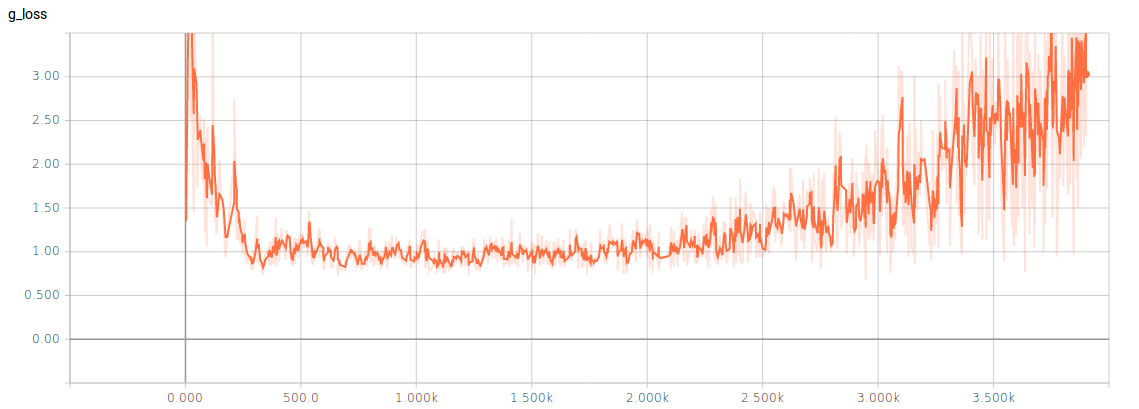
Discriminator
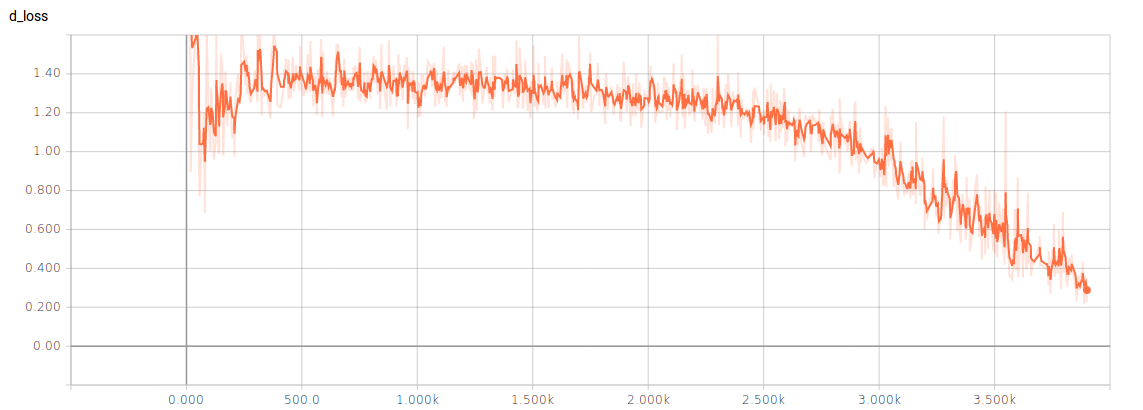
These losses are hard to interpret. So far, there is no accepted way to interpret them, because we don’t know exactly when DCGANs converge, and when to stop training them.
References
We used the DCGAN github repository for our neural network, which can be found here: https://github.com/carpedm20/DCGAN-tensorflow
![]()
We also used a few resources to help with the image conversion and color maps for malmo: http://stackoverflow.com/questions/9694165/convert-rgb-color-to-english-color-name-like-green
